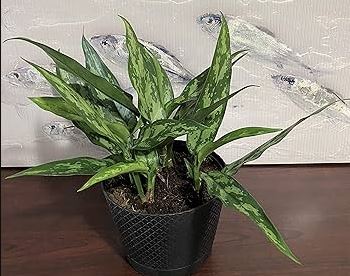
Aglaonema is a genus of flowering plants in the arum family, Araceae. They are native to tropical and subtropical regions of Asia and New Guinea. They are known commonly as Chinese evergreens. The Chinese Evergreen family is among the top houseplants that purify the air and is also on Nasa’s list of air-purifying plants.
Aglaonema ‘Emerald Beauty’ is celebrated for its deep green leaves, which have a glossy finish. The leaves often feature a lighter green or silver pattern, adding a subtle variegation that enhances its beauty. This variety is appreciated for its rich, almost emerald-like color, which gives it its name.
Like other Aglaonemas, it grows in a bushy, upright manner. It’s relatively slow-growing, which makes it manageable for indoor spaces. Typically, ‘Emerald Beauty’ can grow to about 2 to 3 feet in height. The ‘Emerald Beauty’ variety adds a touch of lush greenery to indoor spaces, making it a favorite for those looking to enhance their home or office decor with vibrant, healthy foliage.
Care Requirements
- Light: ‘Emerald Beauty’ thrives in bright, indirect light. It can tolerate lower light conditions, but the best leaf color and growth will be achieved with more light. Avoid direct sunlight to prevent leaf burn.
- Watering: Allow the top inch or two of soil to dry out between waterings. Overwatering can lead to root rot, which is a common issue with Aglaonemas. Ensure the pot has good drainage.
- Soil: A well-draining potting mix is essential. Adding perlite or orchid bark to regular potting soil can improve drainage.
- Humidity: While it can adapt to average household humidity, it prefers higher humidity. You can increase humidity by misting the leaves, using a pebble tray, or placing a humidifier nearby.
- Temperature: Prefers temperatures between 60-80°F (16-27°C). Keep away from cold drafts, air conditioners, or heaters.
- Fertilization: Feed with a balanced houseplant fertilizer every 2-3 months during the growing season (spring and summer). Over-fertilization can lead to leaf burn.
Challenges
- Leaf Browning: Can occur due to low humidity, fluoride in water, or too much direct sunlight. Using distilled or rainwater can help prevent this.
- Pests: Watch out for common houseplant pests like spider mites, mealybugs, or scale. Regularly inspect the plant, especially the undersides of leaves.
- Growth Issues: If the plant doesn’t receive enough light, it might grow leggy or lose its vibrant coloration. Rotate the plant periodically to ensure even growth.